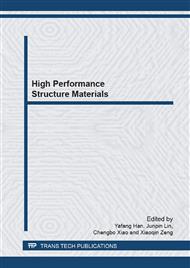[1]
R. Boyer, D. Eylon, and F. Froes. Titanium Science and Technology, Vol. 2. Edited by G. Lütjering, U. Zwicher, and W. Bunk, Germany, (1995).
Google Scholar
[2]
D. Doraiswamy, S. Ankem: Acta Materialia Vol. 51 (2003) 1607-1619.
Google Scholar
[3]
R.R. Boyer, G. Welsch, E.W. Collings. Materials properties Handbook: Titanium Alloys. AMS International, The Materials Information Society, 1994, pp.485-632, 685-865.
Google Scholar
[4]
Nilesh P. Gurao, Ashkar Ali A, Satyam Suwas: Materials Science and Engineering A Vol. 504(2009) 24-35.
Google Scholar
[5]
Crowley G.How to extract low cost titanium.Advanced Materials & Processes. 11(2003) 25-27.
Google Scholar
[6]
B Gunawarman, Mitsuo Niinommi, Toshkazu Akahori, et al. Mechanical properties and microstructures of low cost β titanium alloys for healthcare applications.Materials Science and Engineering C. 25 (2005) 304-311.
DOI: 10.1016/j.msec.2004.12.015
Google Scholar
[7]
Opportunities for Low Cost Titanium in Reduced Fuel Consumption and Enhanced Durability Heavy-Duty Vehicles. U.S. Department of Energy. July (2002).
DOI: 10.2172/814648
Google Scholar
[8]
D. Kuroda,M. Niinomi,M. Morinaga,et al.Mater. Sci. Eng. A. (1998)243-244.
Google Scholar
[9]
Mo Sherman, C.J. Sommer, and F.H. Froes. The Use of Titanium in Production Automobiles: Potential and Challenges. JOM Journal of the Minerals, Metals and Materials Society. Volume 49, Number 5(1997)38-41.
DOI: 10.1007/bf02914682
Google Scholar
[10]
B. Gunawarman, Mitsuo Niinomi, Toshikazu Akahori, Takayuki Souma, Masahiko Ikeda, Hiroyuki Toda. Mechanical properties and microstructures of low cost β titanium alloys for healthcare applications. Materials Science and Engineering C. 25 (2005).
DOI: 10.1016/j.msec.2004.12.015
Google Scholar
[11]
Yoji Kosaka, Stephen P. Fox, Kurt Faller, and Steven H. Reichman. Properties and Processing of TIMETAL LCB[J]. Journal of Materials Engineering and Performance, Volume 14(6) December 2005, pp.792-798.
DOI: 10.1361/105994905x75637
Google Scholar
[12]
F.H. Froes, H. Friedrich, J. Kiese, and D. Bergoint. Titanium in the Family Automobile: The Cost Challenge. JOM Journal of the Minerals, Metals and Materials Society. Volume 56, Number 2, 2004, pp.40-44.
DOI: 10.1007/s11837-004-0144-0
Google Scholar
[13]
Y.M. Hu, W. Floer, U. Krupp, H. -J. Christ. Microstructurally short fatigue crack initiation and growth in Ti-6. 8Mo-4. 5Fe-1. 5Al. Materials Science and Engineering.A. 278 (2000) 170-180.
DOI: 10.1016/s0921-5093(99)00575-4
Google Scholar
[14]
L Weiss, R. Srinivasan, M. Saqib, N. Stefansson, A.G. Jackson, and S.R. LeClair. Bulk Deformation of Ti-6. 8Mo-4. 5Fe-1. 5Al (Timetal LCB) Alloy, Journal of Materials Engineering and Performance, Volume 5(3) June 1996, pp.335-352.
DOI: 10.1007/bf02649336
Google Scholar
[15]
Ivasishin, P.E. Markovsky, Yu.V. Matviychuk, S.L. Semiatin, C.H. Ward, S. Foxc. A comparative study of the mechanical properties of high-strength β-titanium alloys. Journal of alloy and Compounds. 14(2007) 1-14.
DOI: 10.1016/j.jallcom.2007.03.070
Google Scholar
[16]
J. C. Fanning in Proceedings of 8th World Conference on Titanium, UK, 1995, p.1688.
Google Scholar
[17]
P. J. Bania. Beta titanium alloys and their role in the titanium industry, beta titanium alloys in the year 1990s. TMS Publish, 1993. 3.
DOI: 10.1007/bf03220742
Google Scholar
[18]
W. Swale, R. Broughton. Application superplastic forming principles to titanium sheet metal forming problems. Proceedings of the 10th World Conference on Titanium, Germany, 2003, p.581.
DOI: 10.4028/www.scientific.net/msf.447-448.239
Google Scholar
[19]
H. Fukai, A. Ogawa, K. Minakawa, H. Sato, T. Tsuzuku. Hot forming characteristics of SP-700 titnaium alloy. Proceedings of the 10th World Conference on Titanium, Germany, 2003, p.635.
Google Scholar
[20]
K.Y. Zhu, Y.Q. Zhao, Y.L. Li. Chinese Patent, Application No. 02101189. 3.
Google Scholar
[21]
Y.Q. Zhao, K.Y. Zhu, Y.L. Li. Chinese Patent, Application No. 02101190. 7.
Google Scholar
[22]
KAR S K. Modeling of mechanical properties in alpha/beta-titanium alloys. Ohio: The Ohio State University, 2005, p.14.
Google Scholar
[23]
Editorial Board of China aeronautical materials handbook, China aeronautical materials handbook, Beijing: China standard press, (2001).
Google Scholar
[24]
O.M. Ivasishin, P.E. Markovsky, S.L. Semiatin, et al, Aging response of coarse- and fine-grained β titanium alloys. Materials Science and Engineering. A. 354 (2005) 296-305.
DOI: 10.1016/j.msea.2005.06.027
Google Scholar


